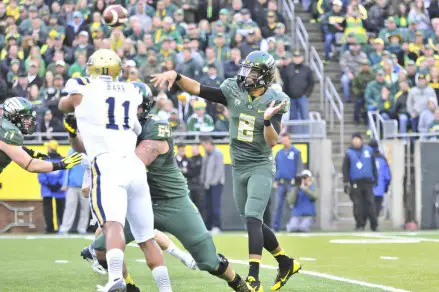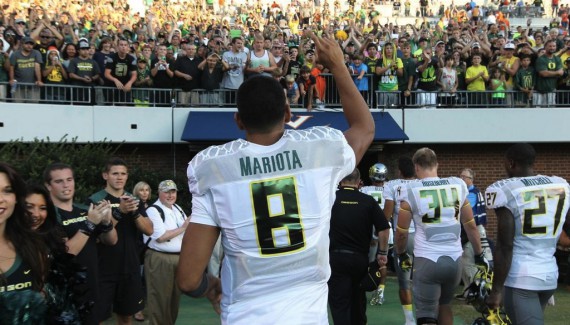While the rankings given out on each National Signing Day may not always reflect it, the Oregon football program has become truly outstanding in its ability to recruit the right players for the right roles.
The Ducks do not necessarily recruit in traditional ways. In fact, over the past 10 seasons or so, Oregon has rapidly become known for its tradition of non-tradition, and that trend begins on the recruiting trail.
Of all the stars that have come in and out of Eugene over the past decade, a huge percentage were either 2-star or 3-star gems, or ended up playing a different position than what they were being recruited to play at other schools.
In simple terms, the Oregon coaching staff is able to see things in players that no one else seems to be able to see. And with the recent decommitment of 4-star stud Budda Baker, it is encouraging to remember this pattern in recent history as we near National Signing Day.
It is not as if the Ducks completely lack traditional talent. However, it always seems that one or two headline recruits per year is Oregon’s limit — Haloti Ngata in 2002, Dennis Dixon in 2003, Cam Colvin in 2004 (though he did bring along some very talented friends from De La Salle), Jonathan Stewart in 2005, Cliff Harris in 2009, Lache Seastrunk in 2010, De’Anthony Thomas in 2011, Arik Armstead in 2012 and Thomas Tyner in 2013.
On top of the limited numbers in terms of 5-star talent coming to Eugene, many of these stars committed at the last minute in the recruiting process, especially after Chip Kelly arrived. DAT was a last-minute flip from USC, and other recent 4-star studs such as Bralon Addison and Terrodney Prevot did not commit until signing day arrived.
While Oregon may be short on headline recruits in terms of quantity, it is certainly not short on quality. Of the names listed above, nearly each player enjoyed (or is enjoying) a successful career in green and yellow, and many became fan favorites.
However, the more impressive part of Oregon football recruiting is the ability of the coaches to find exactly what they need on both sides of the ball with non-traditional talent. If speed and versatility is what they’re looking for, it is safe to say they have found it.

Primarily because of his limited experience in high school, Marcus Mariota was only a 3-star recruit.
To quote Kurt Russell in the movie Miracle, “We’re not looking for the best players, we’re looking for the right ones.”
The Oregon recruiting process certainly subscribes to this philosophy as it seems to tune out national rankings entirely, along with player ratings and anything else that may skew their view of a player’s skill set. This is a strategy that has worked quite well.
Patrick Chung, who is now starting at safety for Chip Kelly on the Philadelphia Eagles, came to Oregon as a 2-star recruit in 2004. That class also found bargains in 3-star linemen Max Unger and Geoff Schwartz, as well as big-bodied receiver Jaison Williams.
The next season, Walter Thurmond III (a 3-star recruit) and Jairus Byrd (a 2-star recruit) joined Chung in a secondary that eventually labeled itself the ‘D-boyz.’ Both Thurmond and Byrd are currently enjoying successful pro careers.
Over the following two years, the Ducks patched together an enormously strong front wall that included Jordan Holmes (2-star), Bo Thran (3-star), C.E. Kaiser (2-star), and Mark Asper (2-star).
In 2007, Jeff Maehl came to Oregon as a 3-star . . . defensive back? We all know how that turned out, as the lean, converted wide out became one of the most reliable offensive play-makers in Oregon football history.
The list goes on and on, but it really culminates in 2011 when Oregon offered scholarships to two 3-star quarterbacks that were at one point both committed to the Ducks. In fact, you may have heard of them. Their names are Johnny Manziel, 2012 Heisman Trophy winner, and Marcus Mariota, a 2014 Heisman hopeful.
Texas and other major schools would not give the undersized-yet-elusive Manziel an offer, but Oregon sure would. Few were ready to take a chance on Mariota, who only had one year of starting experience in high school in Hawaii, but the Ducks had nothing to lose.
For Oregon, the tape did not lie on these players, and general consensus did not discourage the coaches from going all in on these players.
Equally impressive to the Ducks’ ability to seek out talent across the board is their ability to convert players from one position to another to maximize on player skill sets.
The example of Maehl is one of the best, but there are plenty of others. Dion Jordan came to Oregon as a 4-star tight end or wide receiver prospect but left as a Top-3 pick in the NFL Draft as a pass rusher.
Arik Armstead was considered by many to be the natin’s top offensive tackle recruit when he came to Eugene in 2012, but the Ducks needed big bodies on defense. Their solution was to plug the 6-foot-8 monster in at defensive tackle.
And then there is De’Anthony Thomas, who was committed to USC where he was likely to play cornerback. About a week before signing day, he took a visit to Oregon. Chip Kelly offered to give him the ball on offense, and the rest is history.
Though Oregon is certainly not the only team finding success with under-the-radar recruits, most of the nation’s other elite programs rely more on high-profile stars than the untraditional Ducks do on the recruiting trail.
As a Duck fan, it is easy to get nervous about recruiting. It seems as though every season the commitment lists are far too short or not filled with enough talent. However, be comforted fans, as recent history shows — the Oregon football program knows exactly what it is doing.
Top photo by Andrew Shurtleff
Related Articles:
Chip Kelly Update: Everything's Good Again ...
Chip Kelly Update: Wailing and Gnashing of Teeth
Shock and Awe -- The Oregon Ducks' Football Hangover Effect
Despite Lopsided Score, Georgia State "Never Stopped Believing"
Hope Springs Eternal for Ducks
Incompetent Pac-12 Officials: How Do You Miss ALL of THIS?
Joey Holland graduated from the University of Oregon in 2013, majoring in History. He played several sports in high school, though football remains his passion. He has yet to miss a single Oregon Ducks home football game during his time in Eugene. Joey has written previously for Bleacher Report and Football Nation.
Joey welcomes your feedback.



